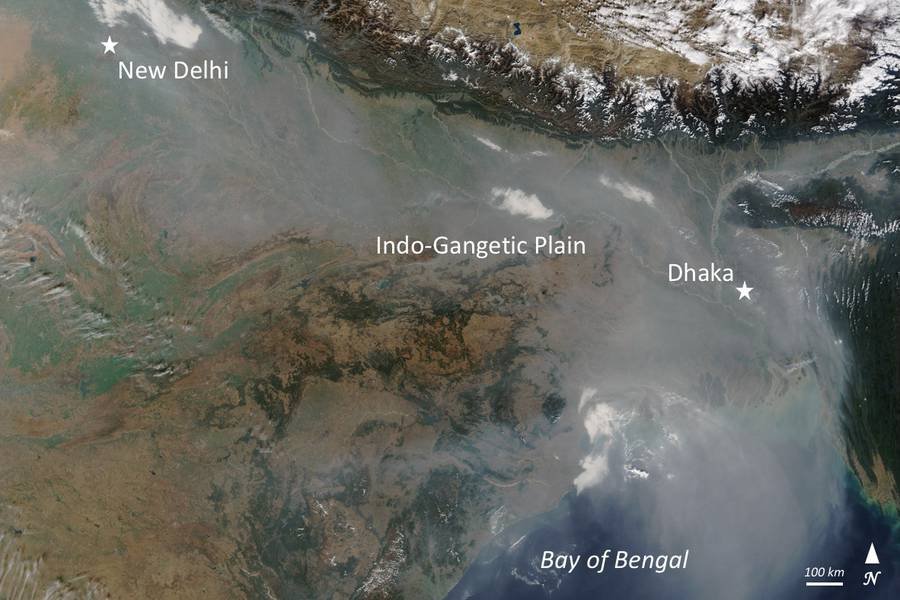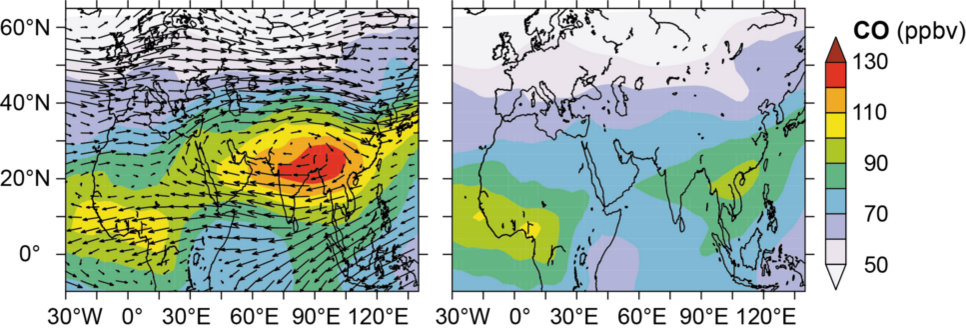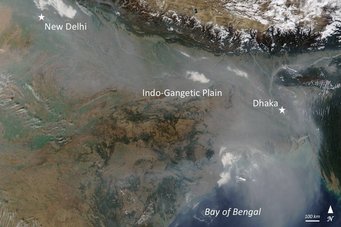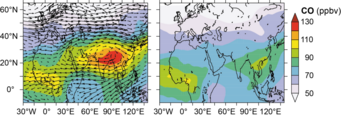The Janus head of the South Asian monsoon
The world's largest weather phenomenon efficiently purifies the air of pollutants, but also distributes them across the globe
The same phenomenon recurs every year. During the dry season, in winter, burning fossil fuels and biomass in South Asia creates a huge pollution haze: the Atmospheric Brown Cloud. How and why it disappears as soon as the rainy season starts in spring has now been clarified by an international team of scientists led by the Max Planck Institute for Chemistry. The result is that thunderstorm updrafts, lightning and chemical reactions enhance the self-cleansing power of the atmosphere, allowing atmospheric pollutants to be efficiently washed out of the air. However, the pollutants that are not eliminated are transported into the upper troposphere by the monsoon and then spread worldwide.
No weather phenomenon defines South Asia as much as the monsoon: this enormous circulation system leads to dryness in winter but brings intense precipitation in summer. The summer monsoon is created by the heating of air masses over the Indian subcontinent and the warm air rising. As a result, humid ocean air is drawn in and flows over land towards the Himalayas. Deep thunderstorm clouds produce rain over the region for months, guaranteeing water supplies and safeguarding harvests.
Atmospheric researchers have long suspected that the rising air masses also transport pollution high into the atmosphere, even above the rain clouds. "We anticipated that gaseous and particulate pollutants are transferred into an anticyclone, a huge clockwise circulation of winds, which forms above the clouds over South Asia as a result of the thunderstorm convection", says Jos Lelieveld, Director at the Max Planck Institute for Chemistry. Geographically, the countries of Bhutan, Nepal, Myanmar, Bangladesh, Tibet, India, Sri Lanka, Pakistan and Afghanistan are part of South Asia. In this region, nitrogen oxide and sulphur dioxide emissions from burning coal and other fossil fuels have increased by fifty percent over the past decade. However, the pollution cloud is also fuelled by other sources, in particular the combustion of biomass by the region's large population.

The monsoon transports atmospheric pollutants and eliminates them
Evidence that the South Asian monsoon actually transports pollutants through the cloud layer as high as the stratosphere has now been provided by an elaborate expedition with the HALO research aircraft: in 2015, the Max Planck Institute for Chemistry, together with colleagues from the Forschungszentrum Jülich, the Karlsruhe Institute of Technology and the German Aerospace Center (DLR), launched the "Oxidation Mechanism Observations" mission (OMO). "Our research flights revealed that the monsoon also effectively removes pollutants from the atmosphere," said expedition leader Lelieveld. The pollutants are carried aloft from the surface and rapidly converted into compounds that are more easily removed by rain.
The scientific team's study thus uncovered the monsoon's virtue but also its downside: a large proportion of South Asia's pollutants moves up above monsoon clouds into the anticyclone. There they accumulate and are then distributed around the globe. For example, almost ten percent of South Asia's sulphur dioxide emissions reaches the stratosphere, which in turn has effects on the climate and the ozone layer. The monsoon therefore not only represents a type of efficient pollutant washing machine, but simultaneously contributes to global atmospheric pollution.
HALO reveals the sources of atmospheric pollution and the degradation processes
The scientists achieved these findings from measurements in the anticyclone: in July and August they flew up to 15 kilometres into the monsoon outflow, between the eastern Mediterranean and the Indian Ocean, and analyzed the composition of the atmosphere with the research aircraft HALO. They passed over regions in the Middle East, the Mediterranean and North Africa to investigate the extent of the phenomenon.
During the survey flights, they identified numerous chemical compounds in order to understand the sources of atmospheric pollution and the chemical processes in the atmosphere: sulphur dioxide and nitrogen oxides, ozone, aerosols, chlorine-containing molecules, hydrocarbons and their degradation products.
More carbon monoxide and sulphur dioxide, but also more hydroxyl
For example, the measurement flights revealed that carbon monoxide and sulphur dioxide concentrations within the anticyclone were significantly increased compared to outside. "The large amounts of sulphur dioxide originate from combustion processes by human activities and are much higher than natural background concentrations," says atmospheric researcher Hans Schlager of the DLR. This, in turn, means that a substantial proportion of atmospheric pollution is transported to altitudes up to 15 kilometres. In addition, the researchers were able to demonstrate that India represents a significant source of pollutants. It was previously assumed that much of the emissions come from China, because the monsoon's area of influence extends as far as East Asia.
"We also analysed the levels of hydroxyl radicals and found significantly higher concentrations within the anticyclone than outside it", relates Max Planck researcher Hartwig Harder, who was present during the entire expedition. The hydroxyl molecule (OH) is better known as the atmospheric cleansing agent because it is highly reactive and efficiently oxidizes pollutants. Chemically, this has two effects: on the one hand, their solubility and thus their ability to lock on to existing airborne particles change, making them easier to wash out of the atmosphere by precipitation. On the other hand, the oxidized molecules can combine to form new aerosols. Because the anticyclone expands widely and disperses the particles, this effect can impact the global climate.

More atmospheric cleaners thanks to lightning
The atmospheric cleanser OH primarily forms when ozone and water are broken down by sunlight. Once the radical has reacted with pollutants, it is generally lost. However, if nitrogen oxides are present, it is recycled and can purify repeatedly, explains the atmospheric chemist Andreas Hofzumahaus of Forschungszentrum Jülich. Nitrogen oxides are formed not only by the combustion of diesel fuel, but also by lightning in the atmosphere. Because lightning frequently occurs during monsoon thunderstorms, the self-cleaning power at 15 kilometres altitude is maintained despite the atmospheric pollution. According to the scientists, even much more OH is recycled than is primarily formed.
This means, then, that the monsoon weather phenomenon not only pumps pollutants high into the atmosphere, but simultaneously provides a cleaning mechanism to remove some of those pollutants again.
This explanation was confirmed by the results of an established numerical model system, which computes the chemical processes in the atmosphere globally. Based on this model, it is possible to determine, among other things, the concentrations of individual chemical compounds such as carbon monoxide, sulphur dioxide, hydrocarbons, nitrogen oxides and those of the OH radical – verified based on the measurements. The OH decreases by a factor of two to three if the scientists do not take into account the nitrogen oxides produced by lightning in the model.
Because it can be assumed that pollutant emissions in the region will continue to increase in future years, the researchers headed by Jos Lelieveld are interested in how the two faces of the Janus-headed South Asian monsoon will develop in the future: Will the cleaning and transport mechanism continue to exist side by side or will they be tilted in one direction or the other?
About HALO
The research aircraft HALO is a joint initiative of German environmental and climate research facilities. HALO was procured from Federal Ministry of Education and Research, Helmholtz Association and Max Planck Society funding. HALO's operation is supported by the Deutsche Forschungsgemeinschaft (German Research Foundation), the Max Planck Society, Forschungszentrum Jülich, the Karlsruhe Institute of Technology and the Leibniz Institute for Tropospheric Research in Leipzig (TROPOS). The German Aerospace Center (DLR) is simultaneously owner and operator of the aircraft.
Further information
www.halo.dlr.de

